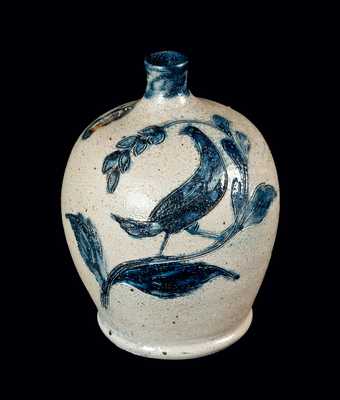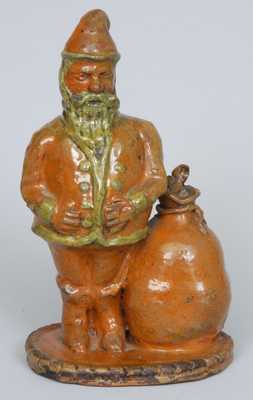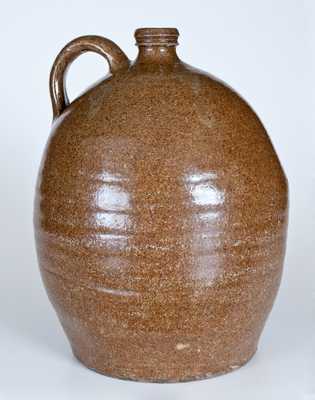Important and Possibly Unique Figural Stoneware Bank, attributed to the J.L. Matthews Pottery, Rock Mills, Alabama, circa 1890-1910, wheel-thrown bank in the form of a coated man with applied face and arms, holding a bell-shaped urn. Carved horizontal slot in reverse. Surface covered in a salt glaze over dipped Albany slip. The figure's well-executed face includes ears with pierced holes at the center, a nose with carved nostrils, a pronounced chin, and an open mouth with porcelain-sherd teeth. The finely-rendered eyes feature applied lids encapsulating two porcelain sherds forming the whites and flattened balls of clay creating the pupils. Incised hair surrounds the base of the head. The figure's coat includes a rounded collar and raised trim flanking an applied X-shaped tie and button on the underlying shirt. The robust arms, which reveal potter's knife carving marks, taper down to thin hands with incised fingers holding a hollow, wheel-thrown urn. This extraordinary example of Southern folk pottery is one of the finest American stoneware banks we have seen. The overall style of the figure, including aspects of the form, its arm structure, clothing treatment, and glaze, all lead to a firm attribution to the James L. Matthews Pottery of Rock Mills, Alabama, circa 1890-1910. Among known examples from this operation are two figural bottles, the first incised "W.H. Macon / Mfg. by J.L. Matthews / Rock Mills, AL", and the second incised "W.J. Baucom from W.H. Macon". A third Alabama bottle, probably also from the Matthews Pottery, sold as part of the well-known John Gordon Sale at Christie's in 1999. It is important to note that the refinement and quality of this bank exceeds all other figural works from this school we are aware of. The modeling of the face and eyes reveals a level of sophistication not seen in the three previously-mentioned figures, which have a more stylized or "grotesque" appearance. The addition of an urn held in front of the figure is a remarkable decorative feature unknown to us in any other Southern sculptural works from the period. Its inclusion into the sculpture dramatically increases the object's value as a work of folk art. Given that the piece was made as a coin bank, a possible interpretation of this sculpture is that the figure represents a beggar holding out a pot to receive money. Of additional significance is the form and purpose of the figure. Banks remain one of the most desirable products in utilitarian American ceramics. While a small number of human-form jugs and decorative figures from Alabama are known, this piece is the only figural bank from this state that we have seen. The fact that no coins have been placed inside indicates a level of importance to its owner. Southern figural stoneware of this quality is rarely made available at public auction. The whimsical and highly-decorative nature of this example is particularly noteworthy. Literature: For an example from the same school, see Christie's, Jan. 15, 1999, The John Gordon Sale of Folk Americana, lots 1167. For more information on Alabama face vessels and photos of similar examples, see pp. 92-93 of The African-American Tradition in Decorative Arts by John Michael Vlach, University of Georgia Press, 1978. Provenance: A fresh-to-the-market example, discovered in the attic of a home in Alabama, wrapped in a quilt. In-the-firing contact marks and kiln residue to head. Urn with a small chip and minor nick to bottom edge. A faint 2 1/2" hairline extending from figure's shoulder to edge of urn. Three short, faint lines from slot in reverse. H 9".
























